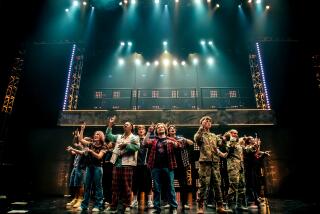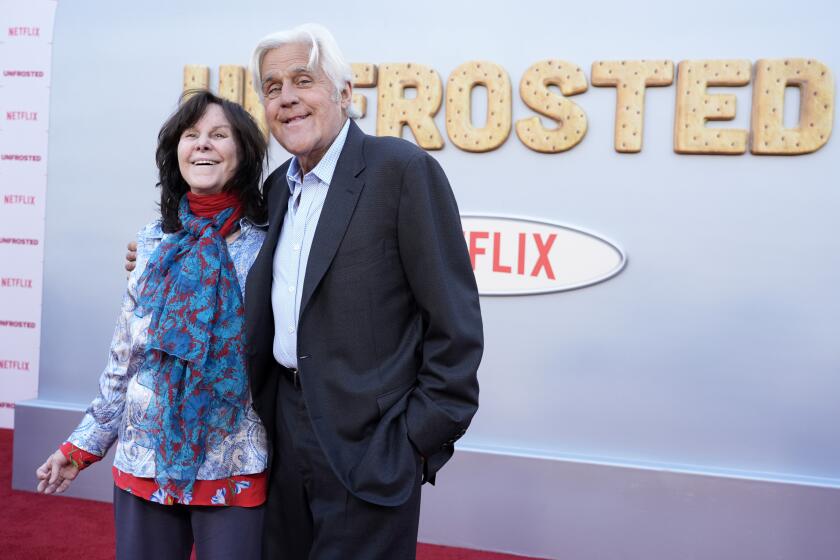Costume Designer Builds Bridges to Non-Hearing : Creativity: Deafness hasn’t kept Donald Baer from being a success, both on an off stage.
- Share via
SAN DIEGO — In The Costume Shopin North Park, fingers are flying. Not downstairs where the masks and feather boas and elaborate get-ups are sold or rented, but upstairs, where design and creation of theatrical costumes takes place. The fingers aren’t furiously cutting and sewing; they’re signing. Donald Baer, assistant costume designer for the San Diego Comic Opera production of “Princess Ida,” the Gilbert and Sullivan operetta, is showing his brother around. Both men are deaf. The conversation is in American Sign Language.
Baer, whose stage name is Chris, seems to be at home among the costumes, especially the elaborate headpieces he has designed for “Princess Ida,” which opens June 19. The amazing thing about the animated, bright-eyed Baer is that he seems to make himself at home wherever he goes.
The fourth of seven children, three of whom are deaf, Baer has had experience in film (documentaries for deaf education, and an extra in “Brewster’s Millions”), television (a closed caption News 8 commercial for the deaf, a PBS documentary on Deaf People in the Workplace, talk show appearances and an ABC special on “Christmas in Disneyland”), and in theater, both onstage and backstage (in college and in two Los Angeles-area deaf theater companies, where he acted as well as designed sets and costumes); and, in several special performances, mostly for deaf audiences, he served as narrator-actor of “Apologies from the Lower Decks,” a 1991 dance performance piece by San Diego’s Malashock Dance Company. He’s had many successes but no formal training in any of these arenas.
“He’s not a Jack-of-all-trades and master of none,” said Pam Stompoly, resident costume designer for the San Diego Comic Opera. “He masters everything he sets out to do.”
Stompoly first met Baer three years ago, when he began coming to the Costume Shop to buy materials. For the past nine years, Baer, 32, has been an enthusiastic participant in the Hollywood Halloween Costume Ball, a lavish annual competition.
He’s won awards eight times. He took the championship in 1984 for best original costume, with his Silver Bird of Paradise. In 1988, he captured the award for Best Female, with his down-to-the-very-last-detail Wicked Witch of the West. After that, Baer became an avid collector of Oz memorabilia.
A lifetime of Halloween costumes is displayed in a photo album he has brought to The Costume Shop. The designs are incredibly intricate, all hand-made by Baer. “He started coming into the Shop regularly,” says Stompoly, “and we became friends. He would ask me questions about costumes and makeup. I saw how talented he was, and I knew I wanted him to work with me on a show. I was just waiting for the right one.”
“Princess Ida” seems to be the one. Stompoly gave Baer a rough idea of what she was looking for--headpieces for the professor of humanities and the professor of sciences. The results were two large, silver, glitzy, futuristic creations. “He’s lived up to expectations and gone beyond,” Stompoly beams.
Stompoly does not know sign language. “I have this thing with foreign languages,” she explains. “My retention is miserable. Chris and I write to each other--faster than I could ever sign. Sometimes, we start drawing sketches, and write a few words, and he knows just what I want. He says we have a telepathic link. He’s got a head full of pictures that he brings to life. That’s what we have in common. And a belief in the magic of theater. Communication has never been a barrier. He’s a brilliant designer who just happens to be deaf. It’s something I usually forget.”
It’s not a big issue to Baer, either. He does not use his voice or speech and, like any other deaf person, cannot rely exclusively on lip reading (80% of English is not readily discernible on the lips). “My parents were hearing,” he signs to the interviewer, “but I grew up in the deaf world; I was comfortable there. But I also wanted to experience the hearing world, with its different language and perspective. I was discouraged in my desire for acting and design careers.
“I’ve learned that it’s possible to progress in the hearing world, but I’m still more comfortable in the deaf world, with my language, my culture, my ability to get along. With hearing people, it’s a bit of a struggle; I always have to teach them. It’s like any two cultures. We need to interact, to work together, to have a cultural meeting of the minds.”
This week, Baer embarks on another bicultural enterprise: a five-week intensive professional acting training program with the bilingual National Theater of the Deaf (NTD) in Connecticut. He auditioned with 250 others, and was one of 30 accepted. After the training, he plans to audition for the 10-month NTD national tour. “Inside,” he confesses, “I have great confidence that I will get one of the four openings in the tour. That’s my destiny.”
Baer’s first foray into acting was at age 7, when he played all the roles in “Mary Poppins” at home for family and friends. He acted in plays throughout his years at schools for the deaf.
When he moved to San Diego several years ago, Baer took a hiatus from his theatrical career, teaching sign language at Mesa College, working in the Job Search Program at Deaf Community Services in San Diego, then as a linguistics and sign language researcher at the Laboratory for Language and Cognitive Studies at the Salk Institute in La Jolla.
But he felt “unfulfilled and frustrated,” he signed, blue eyes flashing. “I enjoyed teaching and research, but I felt that I was missing something in my heart. When I started relating to Pam (Stompoly), I realized where I belonged. My heart is in the theater world.”
Deafness has never posed an obstacle to Baer in that world, and he doesn’t want his experiences misrepresented with cliches and stereotypes about deaf people. “Don’t you dare write anything about ‘silence’ or ‘handicap,’ ” he threatens, with a smile. “I don’t think of myself as handicapped, and I’m certainly not silent. I’m very visually loud. And I’m creatively loud.”
More to Read
The biggest entertainment stories
Get our big stories about Hollywood, film, television, music, arts, culture and more right in your inbox as soon as they publish.
You may occasionally receive promotional content from the Los Angeles Times.










